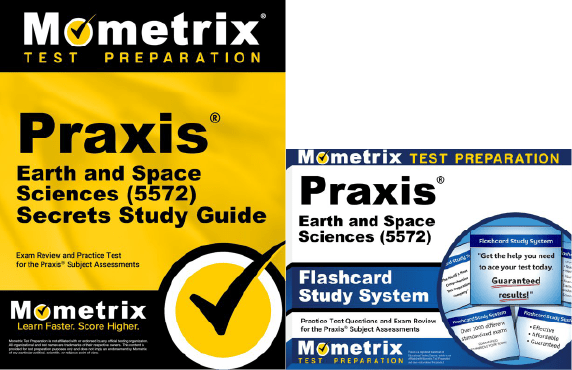If you need help studying for the Praxis Earth and Space Sciences test or just want some more information about what the test is like, you’ve come to the right place!
Click below to take a free Praxis Earth and Space Science practice test!
What’s on the Exam?
First, let’s talk about the questions on the Praxis Earth and Space Sciences test. There are 125 selected-response questions in total.
Selected-response questions can appear in several different forms:
- Single-selection multiple-choice
- Selecting ALL correct answers from a list of choices
- Selecting the correct answer from a drop-down menu
- Clicking parts of a graphic such as a map or a chart
- Dragging and dropping answers into a targeted area on the screen
The time limit for the test is 2.5 hours. There aren’t any scheduled breaks, but you’re free to take restroom breaks as needed!
Let’s take a closer look at the different sections of the Earth and Space Science test:
1. Nature and Impact of Science and Engineering
19 questions
- The nature of scientific knowledge
- Engineering design
- Safety, materials, and standard equipment in the field and the lab
- The interdependence of science, technology, and engineering
- The impact of science, technology, and engineering on the environment and society
- Natural resource management and energy production issues
- Applying science and technology in daily life
2. Earth’s Processes and Materials
56 questions
- The structure and properties of matter
- Energy and matter
- Plate tectonic theory
- Deformation of the Earth’s crust
- Characteristics of earthquakes
- Layered structure of Earth
- Earth’s materials
- Characteristics of rocks
- Rock formation
- Earth’s surface processes and changes over time
- Using rocks to determine geologic time
- Using the fossil record as evidence of the origin of early life on Earth
3. Earth’s Hydrosphere and Atmosphere
28 questions
- Unusual properties of water
- The water cycle
- Energy transfers involved with aerobic and anaerobic cellular respiration
- Surface fresh water and ground water
- The cryosphere
- Physical and chemical characteristics of the oceans
- Basic structure and composition of the atmosphere
- Meteorology principles
- The development of weather systems
- Factors that influence climate
4. Astronomy
22 questions
- Earth’s motions
- Relationships within the Sun-Earth-Moon system
- Characteristics of the components of the solar system
- Characteristics of stars
- The origin, evolution, and characteristics of the universe
How to Register
To register for the test, you’ll need to create an account on the ETS website. Once your account has been created, you can submit your application to take the test.
When you submit your registration, you will need to pay the $130 testing fee.
Praxis Scores
The Praxis Earth and Space Sciences test is scored using a scaled scoring method. Here’s how it works:
For every question you answer correctly, you get one point added to your raw score. At the end of the test, your final raw score will be converted to a scaled score. This scaled score will range somewhere between 100 and 200.
The reason your raw score is converted to a scaled score is because everyone that takes the test is given a slightly different set of questions. Since everyone has a different arrangement of questions, and because some questions are harder than others, converting your raw score to a scaled score ensures a more even playing field.
FAQs
How many questions are on the Praxis Earth and Space Sciences exam?
The exam contains 125 questions.
What is the time limit for the Praxis Earth and Space Sciences exam?
The exam is timed at 2.5 hours.
What is the passing score for the Praxis Earth and Space Sciences exam?
You’ll need to get a final scaled score of at least 154 to pass in most states.
How much does the Praxis Earth and Space Sciences exam cost?
The testing fee is $130.
Mometrix Test Preparation is not affiliated with or endorsed by any official testing organization. All organizational and test names are trademarks of their respective owners.



 Praxis Study Guide
Praxis Study Guide Praxis Flashcards
Praxis Flashcards